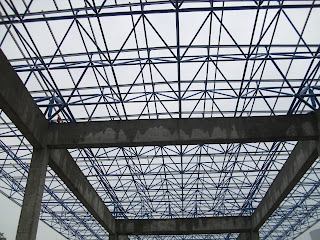Stability analysis of steel structures
At present, there are first-order elastic analysis methods (i.e., traditional calculated length method), second-order P-∆ elastic analysis methods, and direct analysis and design methods (also second-order analysis method) for the stability analysis of steel structures. These three methods appeared successively with the deepening of the theoretical study of steel structure and the development of engineering practice.
Before introducing these three stability analysis methods, it is necessary to understand that the stability analysis of steel structure has the following characteristics: (1) the effect of structural deformation on structural internal force cannot be neglected; (2) the stability analysis is nonlinear (geometric nonlinear), and the principle of load superposition cannot be used; (3) the distinction between static and super-static structure has no significance in the stability analysis.
1. First-order elastic analysis method, which can also be called the length factor method. Its essence is based on Euler's theory of instability, assuming that all columns buckle at the same time, which is also the stable design method stipulated in the 03 edition of the Steel Code. The method has the following characteristics: ① The internal force analysis adopts linear elasticity analysis, i.e., it does not consider the influence of deformation on the effect of external force, and its equilibrium equations are established according to the axes of the structure before the dislocation; ② The stability analysis of the structure is decomposed into the stability analysis and design of members; ③ The deformation characteristic of the structure and the effect of mutual constraints between members on the stability of members are considered through the calculation of length coefficients of the members; ④ Geometrical defects are considered through the additional influence factor, The influence of geometric defects and residual stresses is considered through additional influence factors; ⑤ The preliminary analysis and calculation are relatively simple, but the construction requirements are more stringent in the specific design.
2. The second-order P-∆ P-elastic analysis method considers the P-∆ effect and the overall initial defects of the structure, and its equilibrium equations are established according to the axis of the structure after dislocation. The method does not consider material nonlinearities, only geometric nonlinearities, with the first plastic hinge as the criterion, and does not allow internal force redistribution.
3. Direct analysis and design method, also known as the "second-order higher analysis" method, is an overall structural analysis method based on nonlinear theory, which is based on reflecting the real response of the structural system. In addition to the P-∆ effect of the general second-order analysis, the method also takes into account the P-δ effect, the initial defects of the overall structure and local structural members, the stiffness of the node connections, the elasticity of the material and the residual stresses, etc. The method is characterized by the fact that the analysis and design stages are carried out in the same way as in the second-order analysis. It is characterized by the fact that the analysis and design phases are inseparable. The two have simultaneous parts (e.g., initial defects should be introduced at the time of analysis) and separate parts (e.g., the analysis to obtain the stress state, and then use the design criterion to determine whether it is plastic or not). The two are continuously revised and interact with each other in nonlinear iterations until equilibrium is reached at the design load level. This direct analysis method is different from the general nonlinear analysis method, the traditional nonlinear emphasizes the analysis but ignores the design of many requirements, and therefore the results can not be "directly" as the basis for design.
The calculation accuracy and application range of the above three methods are increasing in turn, but the nonlinear processing capability of the calculation software is also more and more demanding. For complex structures, the first-order analysis method is often difficult to calculate clearly, and the corresponding construction measures are also difficult to implement, so priority should be given to direct analysis and design methods. Although the first-order analysis method is less applicable to actual projects, it is still a method that structural engineers need to master in the current steel structure design due to its simple and clear mechanical concepts and easy calculation.
I welcome friends from all walks of life to discuss steel construction with me.
📞 +86 177 1215 7165




评论
发表评论